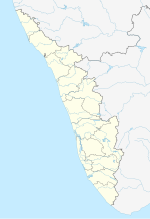Nilambur Elephant Reserve is a wildlife reserve in Kerala, India. It has a total area of 1419 (sq. km2)[1][2] and was created in 2002 as part of Project Elephant. The reserve is one of four in Kerala; the state having an elephant population of 5706 in 2018.[3][4]
| Nilambur Elephant Reserve | |
|---|---|
 Elephants in the forest in Nilambur | |
| Location | Nilambur, Kerala |
| Nearest city | Nilambur |
| Coordinates | 11°16′N 76°28.5′E / 11.267°N 76.4750°E |
| Area | 1,419 km2 (548 sq mi) |
| Established | 4 April 2002 |
History edit
The Nilambur Elephant Reserve was created by the government of Kerala on 2 April 2002 as part of the 'Project Elephant' scheme.[5][6] It spreads across the districts of Palakkad, Malappuram and Kozhikode[5] and is part of the South Nilgiri Elephant Range - 8.[7] Within the reserve are the Silent Valley and Mukurthi national parks, as well as Nilambur South and North Forest Divisions inclusive.[8][9][10]
Fauna edit
As well as elephants, the South Nilgiri Elephant Range 8 has a diverse fauna including leopards, tigers, leopard cat, gaur, Nilgiri tahr, sloth bear, wild boar, lion-tailed macaque; sambar deer and three other species of deer.[10]
In a 2010 study the elephant population in the Nilambur reserve was observed at being either 205 or 647 depending on the use of the block count or dung count method respectively.[6][11] In 2011, the reserve had a total density of 0.1745 elephants per km[6] and as of 2017 the density is 0.25 elephants per km.[12]
| [6] | 2005 | 2007 | 2010 | 2017 |
|---|---|---|---|---|
| Block | 281 | 87 | 205 | |
| Line-Transect | 334 | 663 | 647 |
Connection edit
Nilambur reserve is connected to several other areas. The Nilambur-Appankapu corridor is 0.4 km long and widthwise, it connects Nilambur with the Vazhikadavu ranges of the North forest division. This corridor sees use by elephants moving between Wayanad South and the forests of Gudalur in Tamil Nadu. It is obstructed by households and a rubber plantation at Appankappu.[13]
Between Nilambur Kovilakom and New Amarambalam is a corridor of 1 km length and 0.4 km width, which reaches into the Silent Valley and Mukurthi national parks in the Nilgiri biosphere. The corridor is dissected by the Gudalur-Nilambur road, presenting an obstacle for elephants.[13]
On the border between Kerala and Tamil Nadu is a 35 km long corridor connecting Nilambur to Bandipur and Mudumalai. Unlike other corridors, its width is 0.1 km. The NH67 road dissects the corridor and numerous agricultural estates and 26 settlements are also situated along it.[13]
The elephant populations in the range of Nilambur, the Silent Valley and Coimbature are connected via the Kallar corridor to populations in the Bhrahmagiri, Nilgiris and Eastern Ghats range.[14]
References edit
- ^ Ghosh, Asish Kumar (2008-01-01). A Comprehensive Handbook on Biodiversity. The Energy and Resources Institute (TERI), 2008. p. 62. ISBN 9788179931653.
- ^ Sharma, P.D (2005). Ecology and the Environment. Meerut: Rastogi publications, 2005. p. 325. ISBN 9788171339051.
- ^ Viju, B.; Oppilil, P. (2015-08-13). "100 elephants killed in 2 years across south". The Times of India. Retrieved 16 January 2017.
- ^ Muringatheri, Mini (2020-06-05). "Elephants in troubled waters". The Hindu. Retrieved 2022-06-03.
- ^ a b Ghosh, Arin; Baskaran, N. (2007-08-27). "Southern India Project Elephant evaluation report" (PDF). asiannature.org. Asian Nature Conservation Foundation. Retrieved 2017-01-17.
- ^ a b c d "Protected area network of Kerala". Retrieved 2017-01-13.
- ^ "Profiling of elephants in Coimbatore Forest Division begins". The Hindu. 2020-09-25. Retrieved 2022-06-03.
- ^ "Park Administration". Silent Valley National Park. 2018. Retrieved 2022-06-03.
- ^ "Introduction". Government of Tamil Nadu Forest Department. 2016. Retrieved 2022-06-03.
- ^ a b Easa, P.S. "Project Elephant - Management Plan for Elephant Reserves in Kerala" (PDF). Kerala Forest Research Institute. Retrieved 2022-06-02.
- ^ Venugopal, P. (2011-11-03). "Wild elephant population stable in Kerala: census". The Hindu. Retrieved 16 January 2017.
- ^ Perinchery, Aathira (19 August 2017). "Kerala's elephant population goes up". The Hindu. Retrieved 19 February 2018.
- ^ a b c "Conflicts among man and elephants rise in Kerala as latter lose habitat". New Indian Express. 2021-10-11. Retrieved 2022-06-03.
- ^ Wilson, Thomas (2021-11-28). "50 hectares in the critical Kallar elephant corridor declared as private forest". The Hindu. Retrieved 2022-06-03.
